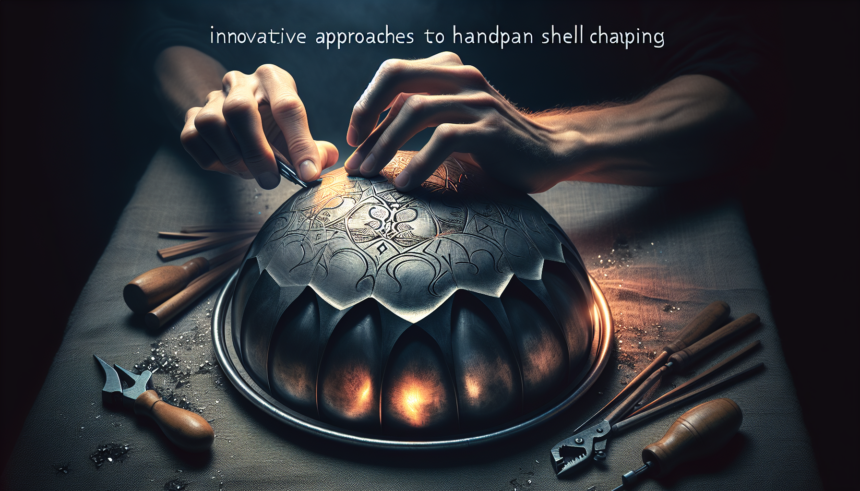Introduction
The handpan, a relatively modern member of the percussion family, has captivated musicians and enthusiasts worldwide with its ethereal sound and distinct aesthetic. Central to the creation of this unique instrument is the process of shaping its shell, a procedure that significantly influences the handpan’s tonal properties and overall quality. As the demand for handpans continues to grow, craftsmen and innovators are exploring new and innovative methods to enhance shell shaping techniques. This article will delve into some of these groundbreaking approaches and their implications on the handpan-making industry.
Traditional Shell Shaping
Traditionally, handpan shells are crafted using a variety of artisanal techniques. The most common method involves manually hammering steel sheets into the curved, convex shapes that form the top and bottom halves of the instrument. This labor-intensive process requires a high degree of skill and experience, as precise control over the thickness and curvature of the steel is essential to achieving the desired sound quality. While traditional hand hammering is revered for its craftsmanship, it also presents several challenges such as inconsistencies and the physical toll on the artisan’s body.
Hydroforming
One of the most significant advancements in handpan shell shaping is the introduction of hydroforming. Hydroforming is a process that uses high-pressure hydraulic fluids to shape metal. This technique allows for greater precision and uniformity compared to traditional methods. By placing a steel sheet into a mold and applying hydraulic pressure, craftsmen can achieve a consistent shape and thickness, resulting in a more balanced and harmonious sound. Additionally, hydroforming reduces the amount of physical labor involved, making the process more accessible to a wider range of artisans.
Incremental Sheet Forming (ISF)
Incremental Sheet Forming (ISF) is another innovative approach gaining traction in the handpan community. This process involves gradually shaping the metal sheet using a series of small, controlled deformations. ISF is typically performed using computer-controlled machinery, allowing for precise control over the shaping process. This method offers several advantages, including the ability to create complex geometries and fine-tune the curvature of the shell with minimal physical effort. ISF also allows for greater experimentation with different materials and designs, paving the way for new sounds and shapes in the handpan world.
Laser-Cutting and CNC Machining
Technological advancements in laser-cutting and CNC (Computer Numerical Control) machining have also proven to be beneficial in handpan shell shaping. Laser-cutting allows for precise, clean cuts that can be used to form the initial shape of the shell. CNC machining, on the other hand, offers highly accurate control over the shaping process. By programming the desired dimensions into a CNC machine, artisans can achieve a level of precision that is difficult to attain through manual methods. These technologies not only streamline the shell-making process but also open up new possibilities for intricate designs and customization.
Material Innovations
Innovations in materials also play a crucial role in the evolution of handpan shell shaping. Traditional handpans are typically made from nitrided steel, which offers a good balance of durability and tonal quality. However, recent experiments with alternative materials such as stainless steel, titanium, and even composite materials have shown promising results. These new materials can offer different sound characteristics, expanded tonal ranges, and enhanced durability. By exploring these alternative materials, craftsmen can push the boundaries of what is possible with the handpan, creating instruments with unique and diverse sonic qualities.
Acoustic Modelling and Simulation
Acoustic modeling and simulation tools are becoming increasingly valuable in the handpan-making process. By using computer software to simulate the acoustic properties of different shell shapes and materials, craftsmen can predict how a handpan will sound before it is even built. This allows for more informed decisions during the design and shaping process, leading to instruments that meet specific acoustic criteria. Acoustic modeling also facilitates experimentation with unconventional shapes and configurations, potentially leading to groundbreaking new designs and sounds.
Collaborative Efforts
The handpan community is known for its collaborative spirit, and this extends to innovations in shell shaping. Craftsmen, engineers, acousticians, and musicians often work together to push the boundaries of what is possible with the handpan. This collaborative approach fosters an environment of shared knowledge and continual improvement, driving the development of new techniques and technologies. By pooling their expertise, these innovators can achieve breakthroughs that would be difficult to attain individually.
3D Printing and Additive Manufacturing
3D printing and additive manufacturing are being explored as potential game-changers in handpan shell shaping. These technologies allow for the creation of highly complex shapes and structures that would be difficult or impossible to achieve through traditional methods. By printing shells in layers, artisans can achieve precise control over the instrument’s geometry and internal structure. While still in the experimental stage, 3D printing holds great promise for the future of handpan manufacturing, offering new possibilities for customization and innovation.
Sustainability and Environmental Considerations
As with many industries, sustainability is becoming an increasingly important consideration in handpan manufacturing. Innovations in shell shaping are being driven not only by the desire for better sound quality but also by the need to reduce environmental impact. Techniques such as hydroforming and CNC machining can minimize material waste, while the use of sustainable materials and recycling initiatives further contribute to eco-friendly manufacturing practices. By prioritizing sustainability, the handpan community can continue to innovate while also protecting the planet for future generations.
Conclusion
The world of handpan shell shaping is experiencing a period of rapid innovation, driven by advances in technology, materials, and collaborative efforts. From hydroforming and incremental sheet forming to laser-cutting, CNC machining, and 3D printing, these new approaches are revolutionizing the way handpans are crafted. By embracing these innovative methods, craftsmen can create instruments with unparalleled precision, consistency, and sonic diversity. As the handpan continues to evolve, these advancements will play a crucial role in shaping the future of this captivating instrument, ensuring that it remains a source of inspiration and joy for musicians and enthusiasts around the world.
FAQs
- 1. What is the traditional method of shaping handpan shells?
- The traditional method involves manually hammering steel sheets into curved, convex shapes. This labor-intensive process requires significant skill and experience to achieve the desired sound quality and consistency.
- 2. What are the benefits of hydroforming in handpan shell shaping?
- Hydroforming uses high-pressure hydraulic fluids to shape metal, offering greater precision and uniformity. It reduces physical labor and ensures consistent shape and thickness, resulting in better tonal balance and quality.
- 3. How does Incremental Sheet Forming (ISF) improve the handpan-making process?
- ISF involves gradually shaping the metal using controlled deformations, typically with computer-controlled machinery. It allows for precise control, the creation of complex geometries, and experimentation with different materials and designs.
- 4. What role do laser-cutting and CNC machining play in handpan shell shaping?
- Laser-cutting provides precise, clean cuts for initial shell shaping, while CNC machining offers accurate control over the shaping process. These technologies streamline production and enable intricate designs and customization.
- 5. What is the future potential of 3D printing in handpan manufacturing?
- 3D printing allows for the creation of complex shapes and structures layer by layer, offering precise control over geometry and internal structure. While still experimental, it promises new possibilities for customization and innovation in handpan-making.





